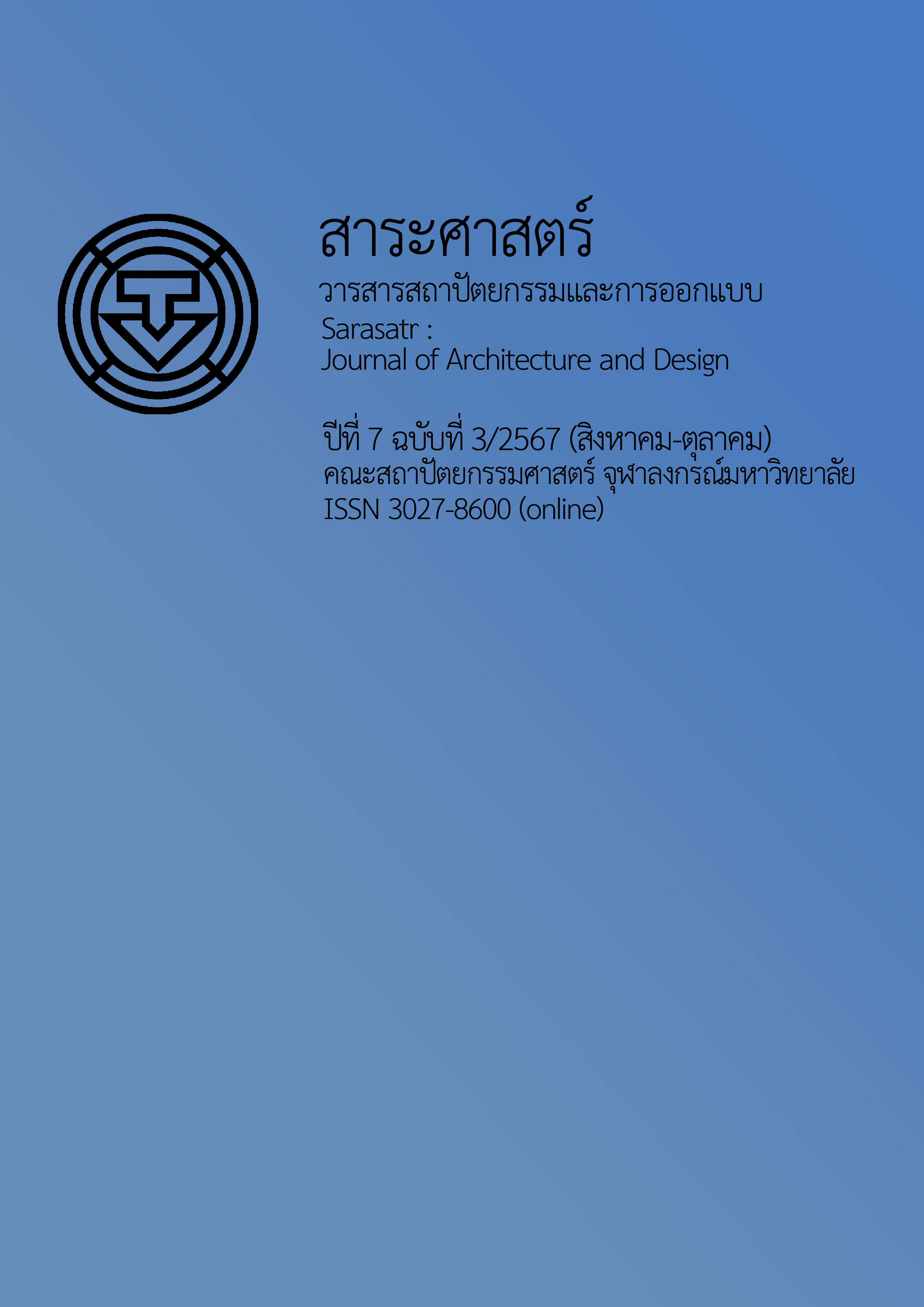Process and Physical Characteristics of Residential Units in the Development of a WELL Building Standard Certified Multi-family Residential Project
Main Article Content
Abstract
In recent years, condominiums have become increasingly popular in Bangkok, and people have begun to pay more attention to living in a way that promotes well-being. This study focuses on the process and physical of residential units in the development of condominium projects that have been certified by the WELL Building Standard. This Standard is a strong emphasis on the well-being of building occupants. In 2022, only one project in Thailand received WELL certification for multi-family residential buildings. This project is a 42-storey condominium with 222 units located in Bangkok. The researcher conducted the study using methods of literature review, project documents, physical observation of the building, and in-depth interviews.
The study found that the development process for WELL Gold Certified Multi-family projects involves seven additional steps compared to non-certified projects. All 26 criteria from 6 of the 7 WELL categories (Air, Water, Nourishment, Light, Comfort, and Mind) must be met in all residential units. These criteria fall into 2 categories: 1) physical criteria (5 items), such as sink size, operable windows, blackout curtains in bedrooms, two-basin deep sink, refrigerator with food labels and compartmentalized storage, under-sink trash bin with hands-free operation, and 2) system criteria (21 items), such as the use of MERV 13 or higher air filters. The air category demands the most extensive measures. The air category requires the most attention. The project developer, WELL experts, and designers agreed that the advantages of developing condominiums under WELL criteria include: 1) residents can be confident that they will live in a healthy environment and 2) the project will have a higher value. However, the disadvantages include increased costs for WELL certification and for materials and equipment that must meet WELL standards.
Article Details
References
กฏกระทรวง ฉบับที่ 55 (พ.ศ. 2543) ออกตามความในพระราชบัญญัติควบคุมอาคาร พ.ศ. 2522. (2543, 7 สิงหาคม). ราชกิจจานุเบกษา. เล่ม 117 ตอนที่ 75กหน้า 16-30.
เกริก บุณยโยธิน. (2564). อาคารเพื่อสุขภาวะที่ดีของผู้ใช้งาน ทางอยู่รอดในยุคโควิด. https://propholic.com/prop-now/%
กาลัญญู สิปิยารักษ์. (2560). การเปรียบเทียบทัศนคติของผู้อยู่อาศัยต่อการวางผังห้องชุดพักอาศัยราคาปานกลาง 4 รูปแบบ : กรณีศึกษา โครงการลุมพินีเพลส รัชดา-ท่าพระ แอสปาย สาทร-ท่าพระ เดอะคีย์ วุฒากาศ และไอดีโอ เอส 115 [วิทยานิพนธ์ปริญญามหาบัณฑิต ไม่ได้ตีพิมพ์]. จุฬาลงกรณ์มหาวิทยาลัย.
เกศินี ศาสตร์ศิริ. (2565). การศึกษาค่าใช้จ่ายที่เพิ่มขึ้นในการขอรับรองมาตรฐานเพื่อความเป็นอยู่ที่ดี (WELL Building Standard) กรณีศึกษาอาคารชุดพักอาศัยสูง 42 ชั้น [วิทยานิพนธ์ปริญญามหาบัณฑิต ไม่ได้ตีพิมพ์]. มหาวิทยาลัยเทคโนโลยีพระจอมเกล้าพระนครเหนือ.
ข้อบัญญัติกรุงเทพมหานคร (พ.ศ. 2544) เรื่องควบคุมอาคาร. (2544, 3 สิงหาคม). ราชกิจจานุเบกษา. เล่ม 118 ตอนพิเศษ 75 ง หน้า 1-34.
คเณศ นิพัทธ์ธีรนันท์. (2562). รู้จักกับ WELL Building Standard เทรนด์มาตรฐานอาคารใหม่ที่เป็นห่วงสุขภาพของผู้อาศัยอย่างแท้จริง. https://www.thestandard.co/anil-sathorn-12/
ชุติมา ศรีอรุณ. (2562). แนวทางการเสริมสร้างสุขภาวะเชิงสถาปัตยกรรมของผู้อยู่อาศัยในอาคารชุดในกรุงเทพมหานคร กรณีศึกษา โครงการเดอะรูมสุขุมวิท 69 และ เดอะรูมสาทร-ถนนปั้น [วิทยานิพนธ์ปริญญามหาบัณฑิต ไม่ได้ตีพิมพ์]. จุฬาลงกรณ์มหาวิทยาลัย.
ณิชารัตน์ อัครมณี. (2561). โอกาสและข้อจำกัดของการพัฒนาโครงการคอนโดมิเนียมโดยใช้แนวคิดสุขภาวะของผู้ประกอบการในเขตกรุงเทพมหานคร [วิทยานิพนธ์ปริญญามหาบัณฑิต ไม่ได้ตีพิมพ์]. จุฬาลงกรณ์มหาวิทยาลัย.
Think of Living. (2564). รีวิวตึกคอนโด High Rise ระดับ SUPER LUXURY ติดถนนสาทร. https://thinkofliving.com/คอนโด/รีวิวตึกเสร็จคอนโด-high-rise-ระดับ-super-luxury-ติดถนนสาทร-รีวิวฉบับที่-2448-834939-รีวิวโครงการ/
บุญชิรา ศรีวงศ์งาม. (2563). การติดตามผลการพัฒนาสภาพแวดล้อมทางกายภาพของสำนักงานสุขภาวะ โดยทัศนคติของผู้ใช้ : กรณีศึกษา ศูนย์วิจัยและนวัตกรรมเพื่อความยั่งยืน (RISC) [วิทยานิพนธ์ปริญญามหาบัณฑิต ไม่ได้ตีพิมพ์]. จุฬาลงกรณ์มหาวิทยาลัย.
พิมพ์นารา อินต๊ะประเสริฐ. (2564). “Good Health and Well-being: เมื่อนิยามของสุขภาพดี’ ไม่ได้หยุดอยู่แค่ร่างกายแข็งแรง”. https://www.sdgmove.com/2021/01/25/sdg-updates- good-health-and-well
ภาวดี ธุววงศ์. (2559). การพัฒนาเกณฑ์การออกแบบอาคารเขียวเพื่อส่งเสริมสุขภาวะสำหรับอาคารที่พักอาศัยแบบยั่งยืนในประเทศไทย [วิทยานิพนธ์ปริญญามหาบัณฑิต ไม่ได้ตีพิมพ์]. จุฬาลงกรณ์มหาวิทยาลัย.
เมธาวี อื้ออารีย์กุล. (2562). องค์ประกอบทางกายภาพของห้องชุดพักอาศัยแบบ 1 ห้องนอนที่ส่งผลต่อสุขภาวะทางใจของผู้อยู่อาศัย : กรณีศึกษาโครงการอาคารชุด บริษัท แอล.พี.เอ็น.ดีเวลลอปเมนท์ จำกัด (มหาชน) [วิทยานิพนธ์ปริญญามหาบัณฑิต ไม่ได้ตีพิมพ์]. จุฬาลงกรณ์มหาวิทยาลัย.
รุ่งรัตน์ เต็งเก้าประเสริฐ. (2549). แนวโน้มรูปแบบอาคารชุดพักอาศัยที่สัมพันธ์กับเส้นทางระบบขนส่งมวลชนระบบราง [วิทยานิพนธ์ปริญญามหาบัณฑิต ไม่ได้ตีพิมพ์]. มหาวิทยาลัยธรรมศาสตร์.
สุธาสินี บุญน้อม. (2563). แนวทางการพัฒนาอาคารชุดเพื่อสุขภาพดี กรณีศึกษา โครงการ จิณณ์ เวลบีอิ้ง เคาน์ตี้ จังหวัดปทุมธานี และโครงการไนท์บริดจ์ ดิ โอเชี่ยน ศรีราชา จังหวัดชลบุรี [วิทยานิพนธ์ปริญญามหาบัณฑิต ไม่ได้ตีพิมพ์]. จุฬาลงกรณ์มหาวิทยาลัย.
IWBI. (2018). WELL building standard v1 with Q3 2018 Addenda. https://resources.wellcertified.com/tools/well-building-standard-v1/
IWBI. (2024). WELL project directories. https://account.wellcertified.com/directories/projects
TERRAMAI. (n.d.). What is the WELL building standard anyway? https://www.terramai.com/blog/well-building-standard/
WELL Building Standard. (2017). New York city residential building achieves first WELL multi-family,residential certification. https://resources.wellcertified.com/articles/new-york- city-residential-building-achieves-first-well-multifamily-residential-certification/
WELL Building Standard. (2019). ASID, Washington D.C.https://resources.wellcertified.com/articles/asid-washington-d-c-/
World Health Organization [WHO]. (1998). The World Health report 1998: Life in the 21st century a vision for all. WHO.


